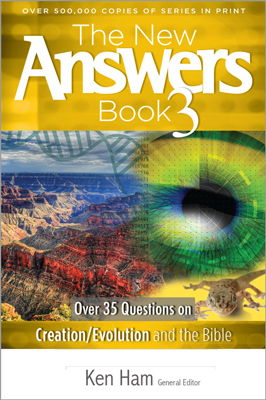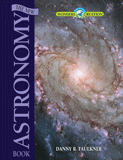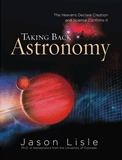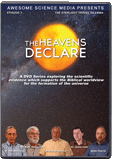
Chapter 19
Does Astronomy Confirm a Young Universe?
One of the common objections to biblical creation is that scientists have supposedly demonstrated that the universe is much older than the Bible teaches. The first chapter of Genesis clearly teaches that God created all things in six days (“ordinary” days as defined by an evening and morning) and that human beings were created on the sixth day. This is confirmed and clarified in the other Scriptures as well (e.g., Exodus 20:8–11; Mark 10:6). And since the Bible records about four thousand years between Adam and Christ (Genesis 5:3–32), the biblical age of the universe is about 6,000 years. This stands in stark contrast with the generally accepted secular age estimate of 4.6 billion years for the earth, and three times longer still, 13.7 billion years, for the universe beyond.
This fundamental time discrepancy is no small matter. It is obvious that if the secular age estimate is correct, then the Bible is in error and cannot be trusted. Conversely, if the Bible really is what it claims to be, the authoritative Word of God (2 Timothy 3:16), then something is seriously wrong with the secular estimates for the age of the universe. Since the secular time scale challenges the authority of Scripture, Christians must be ready to give an answer—a defense of the biblical time scale (1 Peter 3:15).
The Assumptions of Age Estimates
Why such a difference? What is really going on here? It turns out that all secular age estimates are based on two fundamental (and questionable) assumptions. These are naturalism (the belief that nature is all there is),1 and uniformitarianism (the belief that present rates and conditions are generally representative of past rates and conditions).
If these starting assumptions are not correct, then there is no reason to trust the resulting age estimates.
In order to estimate the age of something (whose age is not known historically), we must have information about how the thing came to be, and how it has changed over time. Secular scientists assume that the earth and universe were not created supernaturally (the assumption of naturalism), and that they generally change in the slow-and-gradual way that we see today (the assumption of uniformitarianism).2 If these starting assumptions are not correct, then there is no reason to trust the resulting age estimates.
But notice something about the assumptions of naturalism and uniformitarianism: they are anti-biblical assumptions. The Bible indicates that the universe was created supernaturally by God (Genesis 1:1) and that present rates are not always indicative of past rates (such as the global Flood described in Genesis 7–8). So, by assuming naturalism and uniformitarianism, the secular scientist has already assumed that the Bible is wrong. He then estimates that the universe is very, very old, and concludes that the Bible must be wrong. But this is what he assumed at the start. His argument is circular. It’s the logical fallacy called “begging the question.” But all old-earth (and old-universe) arguments assume naturalism and uniformitarianism. Therefore, they are all fallacious circular arguments. That’s right—all of them.
Refuting an Old Earth and Universe
A much better way to argue for the age of the universe is to hypothetically assume the opposite of what you are trying to prove, and then show that such an assumption leads to inconsistencies. In other words, we temporarily assume naturalism and uniformitarianism for the sake of argument, and then show that even when we use those assumptions, the universe appears to be much younger than secular scientists claim. This technique is called a reductio ad absurdum (reduction to absurdity). So the secular worldview is unreasonable since it is inconsistent with itself. In the following arguments, we will temporarily assume (for the sake of argument) that naturalism and uniformitarianism are true, and then show that the evidence still indicates a solar system much younger than the secular estimate of 4.6 billion years, and a universe much younger than 13.7 billion years.
Moon Recession
Our nearest neighbor, the moon, has much to contribute to the recent creation worldview. A parade of lunar origin theories has passed by over the decades. These include fission of the moon from the earth (1960s), capture of the moon by earth’s gravity from elsewhere in space (1970s), and formation of the moon from the collapse of a dust cloud or nebula (1980s). The currently popular model calls for lunar origin by an ancient collision of the earth with a Mars-size space object. All such natural origin theories are unconvincing and temporary; a recent supernatural creation remains the only credible explanation. Inquiry into origins need not be limited to natural science alone, as often assumed. The historical definition of science is the search for truth. If God is indeed the Creator, then scientists should not arbitrarily dismiss this fact. Many feel that modern science has been impoverished by its artificial limitation to naturalism, or secularism.
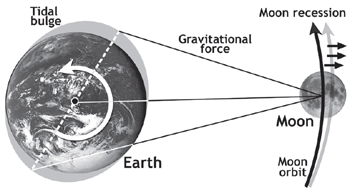
Figure 1. The moon is slowly drifting away from the earth, but the rate of recession would have been much faster in the past.
The moon reveals multiple design features. Lunar tides keep our oceans healthy, protecting marine life. The moon’s (roughly circular) orbit stabilizes the earth’s tilt and seasons. The moon also provides us with a night light, compass, clock, and calendar. The extent to which the moon controls the biorhythms of plants and animals, both on land and in the sea, is not well understood but is surely essential to life.
The moon also instructs us concerning the age of the earth. Consider the gravitational tide force between the earth and moon. This interaction also results in a very gradually receding moon, and slowing of the earth’s rotation. These changes are highly dependent on the earth-moon separation, and are in direct conflict with the evolutionary time scale. Figure 1 shows the spinning earth and orbiting moon. A slight delay in the earth’s high tides (the dark bumps) results in a forward pull on the moon, causing it to slowly spiral outward from the earth. In turn, the moon’s gravity pulls back on the earth, slightly decreasing its spin.
Currently, the moon is moving outward from the earth by 3.82 cm/yr (1.5 in/yr). However, this recession is highly nonlinear and would have been greater in the past. If one assumes unlimited extrapolation back in time, gravity theory shows the moon in direct physical contact with earth about 1.55 billion years ago.3 This is not to say that the moon was ever this near or this old. In fact, a moon located anywhere in the vicinity of the earth would be fragmented, resulting in a Saturn-like ring of debris encircling the earth. This follows because the earth’s gravity force would overcome the moon’s own cohesive force. The tides lead to a limited time scale for the moon, far less than 1.55 billion years. However, evolutionists assume that the moon and solar system are 4.6 billion years old. Also, life is said to have originated on earth about 3.5 billion years ago. The fundamental problem with the evolutionary time scale is obvious.
On a much shorter time scale, 6,000 years, the moon has moved outward by only about 755 feet (230 m) since its creation. Therefore, the creationist suggestion is that the moon was placed in orbit close to its present earth distance. Due to the earth’s rotational slowing, the length of a day 6,000 years ago is calculated to be just 0.12 seconds shorter than at present.
Comets
Comets silently orbit the sun and put on occasional majestic displays in our night sky. Each year, dozens of comets loop the sun. About one-half of them have been named and studied on previous orbits. These comets don’t last forever. Sooner or later they may be ejected from the solar system, may collide with the sun or planets, or they may break into fragments like a poorly packed snowball. There are clouds of dusty debris in the solar system, ghosts of disintegrated comets from the past. When the earth happens to pass through such a cloud, it sweeps up some of this comet dust. Then we see “shooting stars,” an echo of the comet’s original light show. In a spectacular 1994 display, comet Shoemaker-Levi was destroyed when it collided with Jupiter. The gravity of the massive outer planets protects the earth from similar comet collisions.
The question arises, why do comets still exist in the solar system? On a time scale of multiple billions of years, should they not all be long gone, either by escape, collision, or disintegration? The average number of solar revolutions before a comet dissipates is estimated to be about 40 trips. Comet Halley has already been observed through at least 28 orbits, dating back to 240 B.C. Its remaining years are numbered.
How then do secular astronomers explain these apparently “young” comets in a solar system that they believe to be billions of years old?
Astronomers recognize two comet varieties with respectively short and long revolving periods. The short-period comets have orbit times less than about 200 years. Halley’s Comet is such an example with a period of about 76 years. Meanwhile, the long-period comets may require thousands of years for each solar pass. The origin of both kinds of comets remains a mystery to secular astronomers. Based on the rate at which comets are destroyed today, it is surprising (from an old-universe perspective) that either long-period or short-period comets are still present. The supply should have been depleted billions of years ago. How then do secular astronomers explain these apparently “young” comets in a solar system that they believe to be billions of years old?
To account for this paradox, secular astronomers have proposed that myriads of icy, comet-sized objects formed early in the solar system and continue to orbit at a tremendous distance from the sun where they remain permanently frozen for billions of years. It is suggested that every now and then one of these objects is dislodged from its distant orbit and injected into the inner solar system to become a new comet. According to this idea, as old comets are destroyed, new ones replace them.
Two present-day comet reservoirs are suggested by astronomers: one to supply short-period comets, the other to account for long-period comets. The Kuiper belt is thought to exist on the outer fringe of the known solar system, named for astronomer Gerald Kuiper (1905–1973). More than one hundred large, icy objects have been observed beyond planet Neptune, and multitudes more are assumed. It is thought that these trans-Neptunian objects (TNOs) are the largest members of the Kuiper belt. It is assumed that the unseen smaller members of the Kuiper belt occasionally fall inward toward the sun to become short-period comets. Hundreds of times further outward from Neptune is an assumed, vast Oort cloud of icy masses, named for Jan Oort (1900–1992). It is further assumed that a passing star may disturb this remote cloud from time to time, deflecting some of these icy objects toward the inner solar system, thereby replenishing the supply of long-period comets.
So far, the only objects detected at these great distances are much larger than any known comet. The existence of vast Kuiper and Oort clouds of actual cometsized objects is not verifiable with current technology. The simplest explanation would appear to line up with the biblical time scale: the presence of comets may be evidence that the solar system is not nearly as old as is often assumed. Comets teach us two valuable lessons. First, their eventual loss is a reminder of the temporary nature of the solar system and universe. As Psalm 102:25–26 describes it:
. . . the heavens are the work of Your hands. They will perish, but You will endure; Yes, they will all grow old like a garment.
As a second lesson, the exact motions of comets, planets, and stars are elegant evidence of God’s controlling presence throughout the physical universe.
Faint Young Sun Paradox
Astronomers use the term stellar evolution for the aging process of stars. Our sun is assumed to be in its midlife stage, 4.6 billion years of age, as it gradually converts its hydrogen to helium via nuclear fusion reactions in its core. However, a basic time problem arises. Computer modeling of the sun on an evolutionary time scale predicts that the sun must gradually brighten. If true, the sun would be 30 percent dimmer during the period 3.8–2.5 billion years ago. The early earth would have been locked in a global ice age, with the crust and seas frozen solid. This in turn precludes the development of early life on earth.
In conflict with the icy prediction of solar models, geologic evidence points to an earth that was warmer in the past (irrespective of the time scale). This means that there is a fundamental problem with the unlimited extrapolation back in time of solar energy output. The creationist alternative is that the sun was placed in the heavens, on day 4 of the creation week, with a temperature very close to that of the present day.
Rapid Star Aging
Stellar evolution might better be called star decay or degeneration. Current models predict very gradual changes in the nature of stars. The sun, for example, is predicted to pass through several stages in coming ages. At present it is called a “main sequence” star. In the distant future, it is predicted to expand in size and grow cooler as it becomes a red giant star. Following this, the sun reverts to a small, hot white dwarf star. Each stage is assumed to last for millions of years.
Observations suggest that some stars may age much more rapidly than generally believed. For example, consider Sirius, the brightest nighttime star. At a distance of 8.6 light years from earth, it is known as the Dog Star, prominent in the Canis Major constellation. Sirius has a dwarf companion star, and there is intriguing evidence that this dwarf may have formed from a red giant in just the past 1,000 years. Historical records, including those of Ptolemy, describe Sirius as red or pink in color. The suggestion is that the red giant companion dominated the pair at this early time. Today, Sirius is a brilliant blue-white color and its dwarf companion is basically invisible. Other stars also occasionally show unexpected color changes, indicating possible rapid aging processes. Such events call into question the fundamental time scale of current stellar evolution models.
Spiral Galaxies
Spiral galaxies also pose a problem for the secular time scale. Spiral galaxies contain blue stars in their arms. But blue stars are very luminous and expend their fuel quickly. They cannot last billions of years. Secular astronomers realize this and so they simply assume that new blue stars form continuously (from collapsing clouds of gas) to replenish the supply. However, star formation is riddled with theoretical problems. It has never been observed, nor could it truly be observed since the process is supposed to take hundreds of thousands of years. Gas in space is very resistant to being compressed into a star. Compression of gas causes an increase in magnetic field strength, gas pressure, and angular momentum, which would all tend to prevent any further compression into a star. Although these problems may not be insurmountable, we should be very skeptical of star formation—especially given the lack of observational support.
The spiral structure of galaxies strongly suggests that they are much younger than generally accepted.
Perhaps even more compelling is the fact that spiral arms cannot last billions of years. The spiral arms of galaxies rotate differentially—meaning the inner portions rotate faster than the outer portions. Every spiral galaxy is essentially twisting itself up—becoming tighter and tighter with time. In far less than one billion years, the galaxy should be twisted to the point where the arms are no longer recognizable. Many galaxies are supposed to be ten billion years old in the secular view, yet their spiral arms are easily recognizable. The spiral structure of galaxies strongly suggests that they are much younger than generally accepted.
There is a common misunderstanding here because people sometimes confuse linear velocity with angular velocity. Many people have heard or read that spiral galaxies have a nearly “flat” rotation curve—meaning that stars near the edge have about the same linear speed as stars near the core. This is true—but it doesn’t alleviate the problem. In fact it is the cause. A star near the core makes a very small circle when it orbits, whereas a star near the edge makes a very large circle—which takes much longer if the star travels at the same speed. So in physics terminology we say that the stars have the same speed, but the inner star has a greater angular velocity because it completes an orbit in far less time than the outer star. This is why spiral galaxies rotate differentially.
Additionally, some people are under the mistaken impression that dark matter was hypothesized to alleviate the spiral wind-up problem. But this is not so. Dark matter explains (possibly) why the stars have a flat rotation curve to begin with. It does not explain how a spiral structure could last billions of years.
To get around the spiral galaxy wind-up problem, secular astronomers have proposed the “spiral density wave hypothesis.” In this model, as the spiral arms become twisted and homogenized, new spiral arms are formed to replace the old ones. The new arms are supposed to form by a pressure wave that travels around the galaxy, triggering star formation. If this idea were true, then galaxies could be ten billion years old, whereas their arms are constantly being merged and reformed.
However, the spiral density wave hypothesis may create more problems than it solves. There are difficulties in creating such a pressure wave in the first place. The spiral density wave hypothesis cannot easily explain why galactic magnetic fields are aligned with the spiral arms (since magnetic fields move with the material—not with pressure waves); nor can it easily account for the tight spiral structure near the core of some galaxies such as M51. Perhaps most significantly, the spiral density wave hypothesis presupposes that star formation is possible. We have already seen that this is a dubious assumption at best. The simplest, most straightforward explanation for spiral galaxies is the biblical one: God created them thousands of years ago.
Conclusion
Many more such evidences for a young earth, solar system, and universe could be listed. Space does not permit us to discuss in detail how planetary magnetic fields decay far too quickly to last billions of years, or how the internal heat of the giant planets suggests they are not as old as is claimed. In all cases, the age estimates are far too young to be compatible with an old universe. It should be noted that all these age estimates are an upper limit—they denote the maximum possible age, not the actual age. So they are all compatible with the biblical time scale, but challenge the notion of an old universe.
It should also be noted that in all cases we have (for argument’s sake) based the estimate on the assumptions of our critics. That is, we have assumed hypothetically that both naturalism and uniformitarianism are true, and yet we still find that the estimated ages come out far younger than the old-universe view requires. This shows that the old-universe view is internally inconsistent. It does not comport with its own assumptions. However, the biblical view is self-consistent. As with other fields of science, the evidence from astronomy confirms that the Bible is true. The answer to the title of this chapter is a resounding yes—the heavens declare a recent, supernatural creation!
References and Resources for Further Study
- Don B. DeYoung, Astronomy and the Bible (Winona Lake, IN: BMH Books, 2010).
- Danny Faulkner, Universe by Design (Green Forest, AR: Master Books, 2004).
- Jason Lisle, Taking Back Astronomy (Green Forest, AR: Master Books, 2006).
- Jason Lisle, The Ultimate Proof of Creation (Green Forest, AR: Master Books, 2009).
The New Answers Book 3
Do you have answers to the big questions about the Christian faith, evolution, creation, and the biblical worldview? Now you get the important information you need regarding the existence of God, global warming and climate change, cloning and stem cells, human and chimp DNA, the importance of Mount St. Helens, and more.
Read Online Buy BookFootnotes
- Some scientists hold to a softer form of naturalism called “methodological naturalism.” This is the concept that a supernatural realm may indeed exist, but should not be considered when doing scientific study. For all intents and purposes, the naturalist does not accept that there is anything beyond nature—at least when he or she is doing science.
- Uniformitarianism is a matter of degree. Some secular scientists are willing to accept that catastrophes play a major role in the shaping of the earth’s features. However, virtually all of them deny the worldwide Flood, which would have been the most significant geological event in earth’s history since its creation. In this sense, virtually all secular scientists embrace uniformitarianism to a large extent.
- Don B. DeYoung, “Tides and the Creation Worldview,” Creation Research Society Quarterly, 45 no. 2 (2008): 100–108.
Recommended Resources

Answers in Genesis is an apologetics ministry, dedicated to helping Christians defend their faith and proclaim the good news of Jesus Christ.
- Customer Service 800.778.3390
- © 2024 Answers in Genesis

